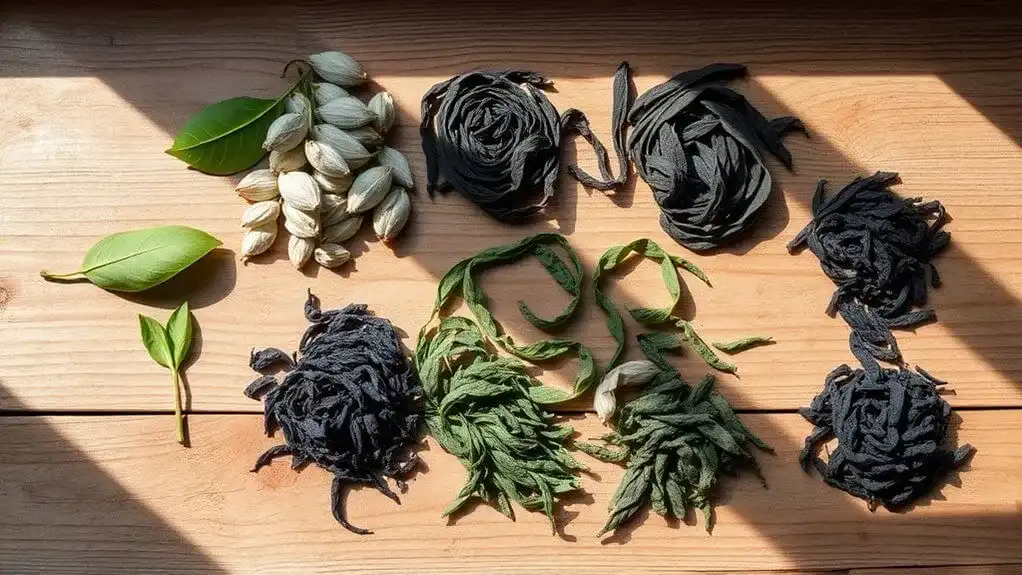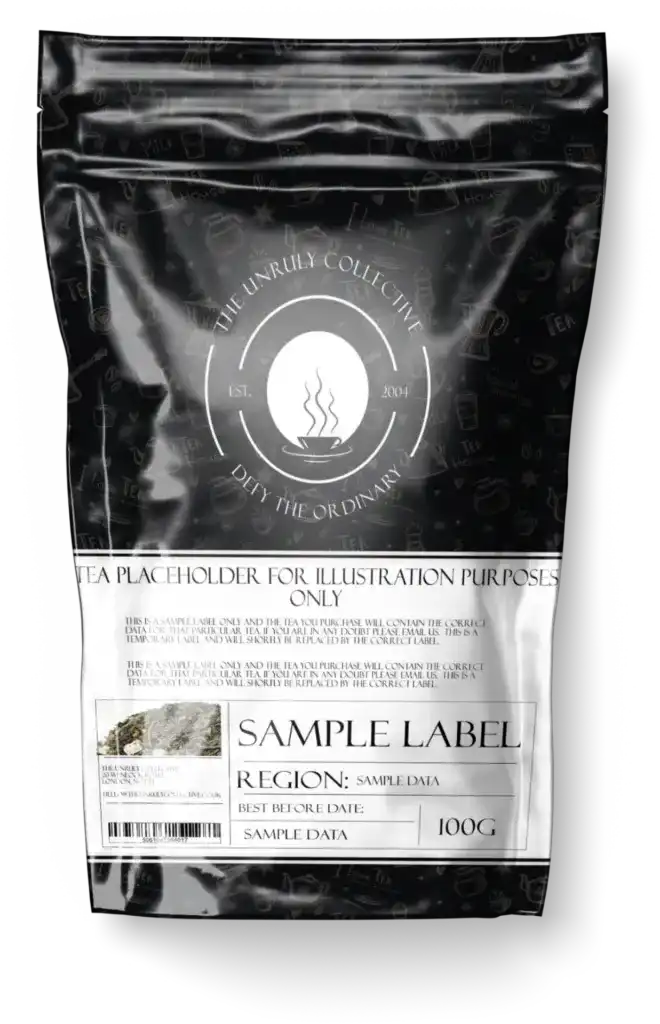Tea processing transforms fresh leaves into six distinct styles through specialized techniques. White tea undergoes minimal processing, while green tea halts oxidation early to preserve freshness. Yellow tea employs unique sweltering methods, and oolong varies in oxidation levels creating diverse flavors. Black tea achieves full oxidation for robust profiles, and pu-erh develops through fermentation over time. Each style's nuanced journey from garden to cup reveals the mastery behind tea craftsmanship.
Key Points
- Tea processing includes six major styles: white, green, yellow, oolong, black, and pu-erh, each creating distinct flavor profiles and characteristics.
- Initial withering reduces moisture content to 45% over 8-18 hours, setting the foundation for subsequent processing steps.
- Oxidation levels distinguish tea types, ranging from minimal in white tea to extensive in black tea, creating diverse flavor outcomes.
- Traditional crafting methods like rolling, kneading, and firing are crucial for developing unique characteristics in each tea style.
- Specialized techniques like yellow tea's "Men Huang" step and pu-erh's fermentation process create distinctive flavor complexities within each style.
The Journey Begins: Understanding Tea Processing
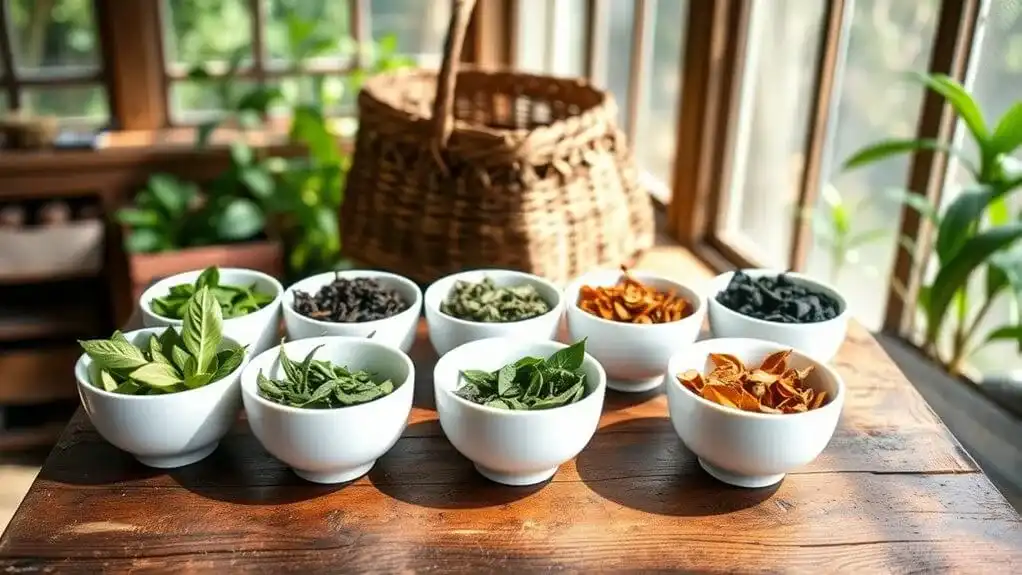
What transforms a simple tea leaf into the complex beverage we comprehend and love? The journey from tea origins to your cup involves a series of carefully orchestrated processing techniques that define the final product's character and quality.
The process begins with withering, where fresh leaves rest on mesh surfaces or bamboo trays for 8-18 hours. During this essential stage, the leaves' moisture content drops to 45%, making them pliable for the next steps. These plucked leaves remain metabolically active during withering, responding to drought stress by producing sweet floral aromas. The leaves then undergo rolling, either through the orthodox method that preserves whole leaf structure or the CTC method that creates smaller pieces. True teas are derived from Camellia sinensis, making them distinct from herbal varieties. Oxidation follows, lasting 30 minutes to 2 hours at 26°C, where enzymes interact with air to develop distinct flavors. Finally, drying reduces moisture to 3%, ensuring the tea's preservation and preparing it for packaging. This ancient process was originally developed in Southwest China, where tea was first domesticated and processed as a medicinal herb.
White Tea: The Pure and Minimal Approach
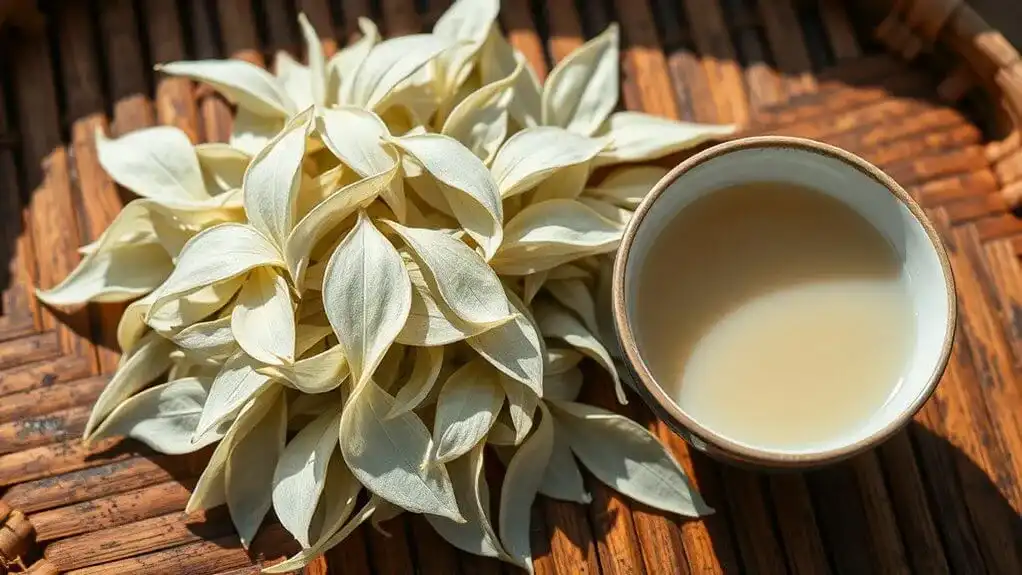
Among all tea varieties, white tea stands as nature's purest expression, requiring minimal human intervention in its journey from field to cup. The process begins with selective harvesting techniques, where only the finest young leaves and buds are handpicked during specific seasons, with premium varieties like Silver Needle using exclusively tea buds. These premium teas are cultivated from medium-leaf varieties and harvested just twice annually for optimal quality.
The withering process forms the heart of white tea production, taking up to 72 hours in carefully controlled conditions. Tea makers spread fresh leaves in shaded environments, allowing them to wither naturally while avoiding harsh midday sun exposure. While Fuding producers utilize outdoor withering methods, indoor withering facilities are essential in Zhenghe due to its rainy climate. Characteristic fine silvery-white hairs appear on the tea buds, creating their distinctive whitish appearance. The final drying stage locks in the tea's delicate characteristics through various methods, from traditional sun-drying to mechanical processes. This minimal processing approach, perfected in China's Fujian province, particularly in Fuding and Zhenghe regions, preserves the tea's natural essence.
Green Tea: Preserving Nature's Freshness
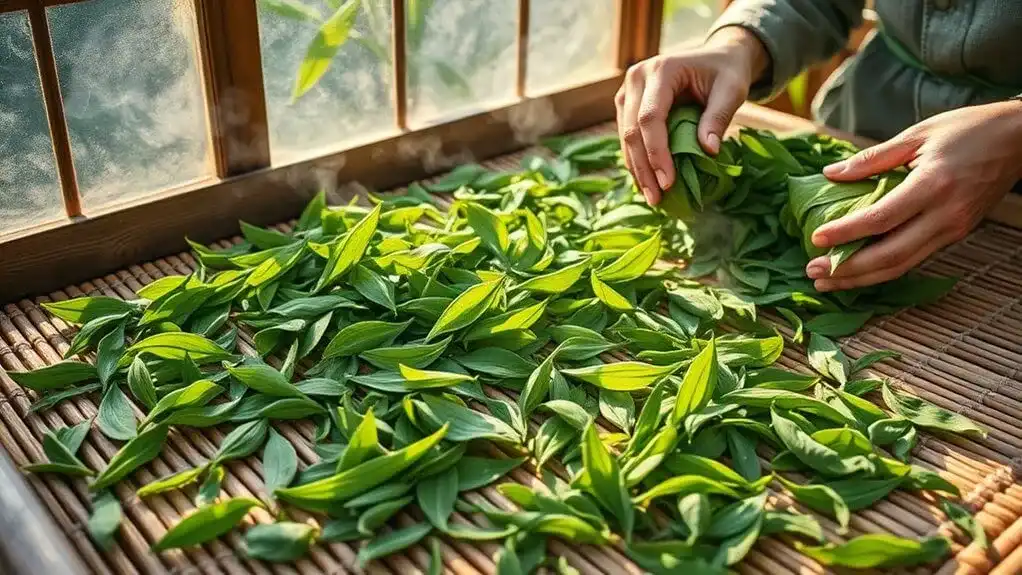
While white tea celebrates minimal intervention, green tea processing represents a careful balance between preserving nature's freshness and applying specific techniques to capture the leaves' vibrant character. The kneading and rolling process creates softer tea leaves that release flavor more readily. Careful leaf selection begins with hand-picking the youngest shoots, followed by withering in some tea varieties. The vital step of either steaming or pan-frying halts oxidation, preserving the tea's fresh flavor and natural compounds. The final product must be stored in airtight containers to maintain its exceptional qualities.
The leaves then undergo a series of rolling processes – from rough to fine – that break down the leaf structure and create distinctive shapes. Each processing technique, whether Japanese steaming or Chinese pan-frying, yields unique aroma preservation characteristics. The final drying stage, conducted at controlled temperatures, reduces moisture to 5% while enhancing the tea's health benefits and ensuring proper storage stability. This careful processing approach has been refined over three thousand years since its origins in China's Zhou Dynasty.
Yellow Tea: The Art of Sweltering

Originally developed as a refinement of green tea processing, yellow tea stands as one of China's rarest and most sophisticated tea varieties. Its unique processing involves withering, fixation through wok roasting, and a distinctive step called "Men Huang," where leaves are wrapped in cloth or heaped in bamboo baskets for controlled oxidation. The process can take up to three full days of careful monitoring to achieve the desired results. The Tang Dynasty marked the period when yellow tea began gaining prominence as a refined beverage choice.
This meticulous process, primarily practiced in regions like Hunan, Anhui, and Sichuan, yields a tea that's mellower than its green counterpart. The controlled oxidation reduces astringency while developing sweet notes similar to black tea and floral hints reminiscent of oolong. The art of yellow tea production is preserved by few tea masters who maintain this traditional craft. Despite its scarcity in European markets, yellow tea's complex production methods preserve beneficial compounds while creating a distinctive flavor profile that tea connoisseurs cherish. Notable examples include the prestigious Jun Shan Yin Zhen from Hunan's Dongting Lake region.
Oolong Tea: Dancing Between Green and Black

Moving from yellow tea's controlled oxidation, oolong tea represents a masterful balance between green and black tea processing. The leaves undergo a meticulous journey, beginning with solar withering outdoors before moving to indoor bamboo or steel trays for further dehydration. Oxidation levels, ranging from 10% to 70%, create diverse oolong varieties with distinct characteristics. Expert producers like Mr. Huang repeat the rolling cycle twenty-four times to achieve the perfect leaf shape. Most premium oolong teas originate from Chinese Fujian province, where the tradition has been perfected over centuries.
The processing continues as leaves are rolled into ball or traditional "shrimp" shapes, followed by slow drying on low-heat conveyor belts. This careful manipulation results in an impressive spectrum of oolong flavors, from light and floral to deep and roasted. Many tea makers expertly control the kill green process to halt oxidation at precisely the right moment. While traditional methods rely on hand-processing and bamboo trays, modern facilities often employ machinery. The final product offers more body than green tea but remains lighter than black tea, showcasing oolong's unique position in the tea world.
Black Tea: The Full Oxidation Experience
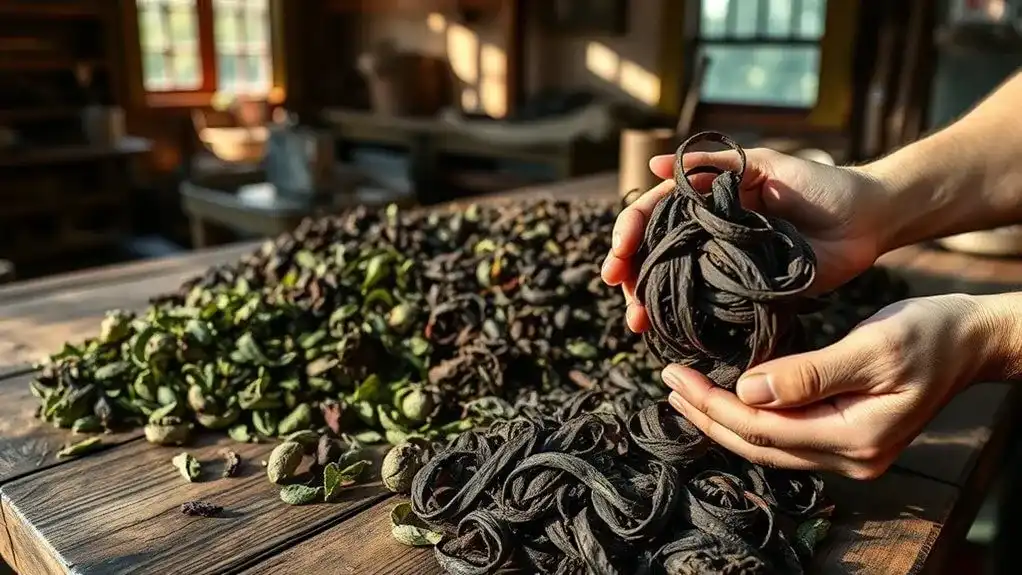
Unlike its lighter tea cousins, black tea undergoes the most extensive oxidation process in the tea family, creating its signature robust flavor and deep amber color. The oxidation process, which typically lasts 45-90 minutes, begins when cell walls break, exposing enzymes to oxygen. During this stage, catechins convert into theaflavins and thearubigins in a carefully controlled ratio of 1:10 to 1:12. For optimal results, tea processors maintain warm humid environments to ensure proper oxidation development. The process involves a significant transformation of amino acids, where amino acid degradation contributes to the tea's distinct flavor characteristics. The production process often incorporates machine processing to meet high-volume demands while maintaining quality standards.
The traditional orthodox method involves rolling the leaves to initiate oxidation, followed by precise temperature and humidity control. The process ends with a final firing stage that reduces leaf moisture to 3-5%. This vital step not only halts oxidation but also contributes to the tea's flavor profile. The result is a rich, astringent taste without bitterness, distinguishing black tea from its less-oxidized counterparts.
Pu-erh Tea: The Age-Old Fermentation Method
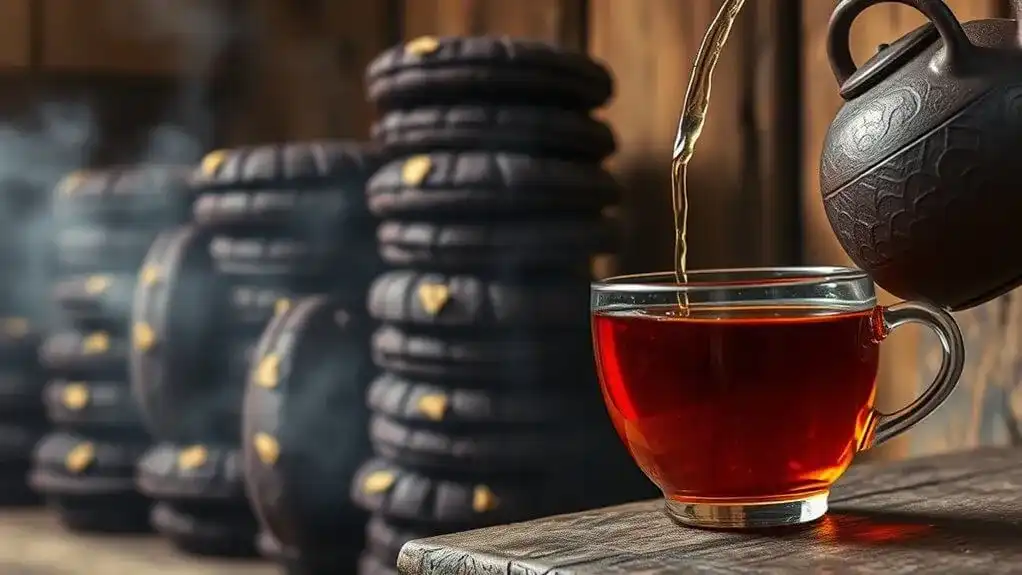
While most teas reach their peak flavor shortly after processing, Pu-erh tea stands apart through its unique aging and fermentation methods that can span decades. This tea comes in two distinct varieties: raw pu-erh and ripe pu-erh, each with its own flavor development path. The tea begins with leaves from the Yunnan big leaf variety of Camellia Sinensis. Tea leaves are harvested during spring and autumn seasons to ensure optimal quality and character.
Raw pu-erh follows traditional processing methods and ages naturally over time, developing complex flavors through gradual maturation. Quality ripe pu-erh produces woody and smooth flavors when properly processed. In contrast, ripe pu-erh undergoes an accelerated fermentation process called "wo dui," where tea leaves are wet-piled and turned regularly for 45 days. This microbial influence creates a darker, earthier brew in a fraction of the time. These aging techniques result in remarkably different outcomes: raw pu-erh maintains a fresh, invigorating character, while ripe pu-erh offers a mellower, more rounded profile.
Conclusion
Like branches stemming from a single tree, these six processing methods transform one plant into an incredible spectrum of flavors, aromas, and experiences. Each style reflects centuries of tea craftsmanship, from white tea's delicate simplicity to pu-erh's complex maturation. Whether you're a casual sipper or aspiring tea master, understanding these methods enriches every cup and deepens your appreciation for tea's remarkable journey from garden to cup.
